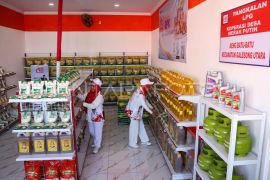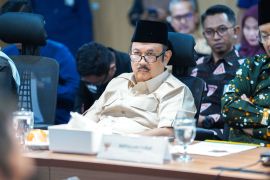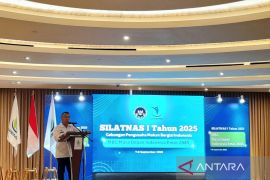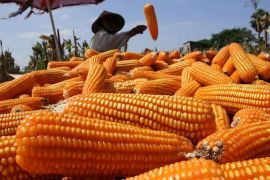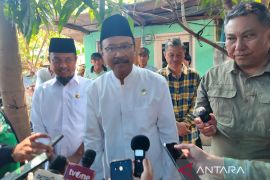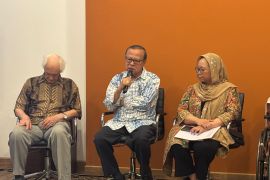The ESDM Ministry has planned to develop 64 new and renewable energy-based power plants, with a total capacity of 400 megawatts (MW).Jakarta (ANTARA News) - The government continues to build power plants in a bid to provide adequate electricity to consumers while avoiding the use of conventional or fossil-based resources that are depleting.
Hence, the government is making efforts to use new and renewable forms of energy to generate electricity since their use will help the country achieve its greenhouse gas emission reduction and energy mix targets.
To this end, the Energy and Mineral Resources (ESDM) Ministry has called on partner companies to develop new and renewable energy-based power plants. According to ESDM Minister Ignasius Jonan, a total of 53 Independent Power Producers (IPPs) have agreed to develop new and renewable energy-based power plants.
The ESDM Ministry has planned to develop 64 new and renewable energy-based power plants, with a total capacity of 400 megawatts (MW).
The new and renewable energy-based power plants will be built in the islands of Sumatra, Java, Sulawesi, and Nusa Tenggara, among others. The plants are being developed to use sources of energy, such as micro-hydro, biomass, and solar power.
"A total of 53 IPPs have agreed to cooperate and sign agreements, including those on developing solar power plants. A power plant project of 10-MW capacity and lower will not need a tender process. The cooperation agreement will use a direct assignment, so that the project can be done sooner. A project of over 10 MW must be put on tender first," Minister Jonan had noted in Jakarta on Wednesday (Aug 2).
The cooperation is based on the sale and purchase principle, so it is not mandatory for the IPPs to agree to it. The IPPs that disagree to it can cancel the agreement. The government is also currently developing sea energy-based power plants. The governments focus is to produce cheap electricity that is within the financial reach of consumers.
This holds significance since it is pointless to generate electricity if there are no consumers to purchase it.
"Hence, we emphasize that regardless of what source the electricity is generated from, it should be cheap and within the purchasing power of the people," Minister Jonan remarked.
Based on information from the ESDM ministry, the initial agreements to develop new and renewable energy power plants comprise 64 IPPs of which 11 did not come during the signing of the agreements, which means they did not agree on the cooperation principles.
However, no information is available on the points of the agreements that the 11 IPPs did not agree to.
"Surely, if they did not agree to it, they would not sign it," the minister emphasized.
The cooperation included agreements for the purchase of new and renewable electricity produced by mini-hydro power plants (PLTm), biomass power plants (PLTBm) and biogas power plants (PLTBb), and solar energy plants (PLTS). All these have a capacity of 10 and less than 10 MW capacity.
The purchase of the new and renewable energy electricity is stipulated in a contract which will expire in 25 years, which commences from the start of the commercial operation date (COD) and with the build, own, operate, and transfer (BOOT) scheme.
Meanwhile, ESDM Deputy Minister Arcandra Tahar noted that Indonesia was open to investment for the development of all kinds of new and renewable energy, but the development of such energies will take the local talents into consideration.
"We will look for local talents and select the types of dominant energy in the region concerned for the development of new and renewable energy," Tahar told a national working meeting of the Ministry of Environment and Forestry (KLHK) in Jakarta on Thursday (Aug 3).
In Europe, for example, where wind is the dominant source of energy, wind energy generators are the plants built. Indonesia has geothermal energy, which is not found in other countries. Hence, there is a need to develop geothermal power plants (PLTPB).
"We will promote the development of wind power plants in areas which have strong winds," Tahar added.
The deputy minister stated that Indonesia was open to all new and renewable energy technology in an effort to achieve its energy mix target of 23 percent in 2015. "It can be based on the solar, hydro, wind, biomass, and other energies," he revealed.
Furthermore, he explained that 53 IPPs have agreed to build new and renewable energy-based electricity plants, including solar power plants. "This is a big leap. But we will continue to make improvements or consider matters that would provide stimulus for the development of new and renewable energy," he added.
Indonesia has reaffirmed its commitment in the Nationally Determined Contribution (NDC) document to reduce its greenhouse gas emissions by 29 percent in 2030.
Meanwhile, Jonan stated that Indonesia was also committed to achieve its target of a 23 percent energy mix use in 2025.
"We will make efforts to reach the energy mix target of 23 percent in 2025 from new and renewable energy sources. This is not easy because until now, we have only achieved about 8 to 9 percent. Probably, we can achieve 12 to 13 percent in in 2019. However, to achieve this target, we need to take extraordinary efforts," Jonan pointed out.(*)
Reporter: Andi Abdussalam
Editor: Heru Purwanto
Copyright © ANTARA 2017

